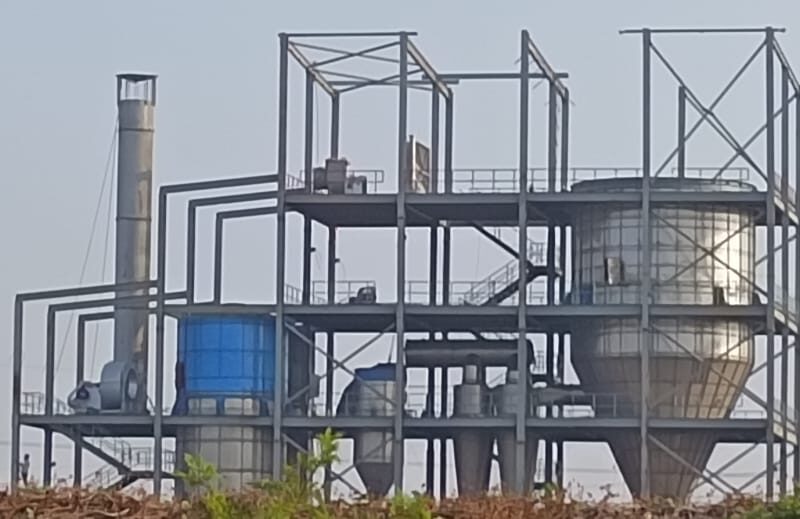Spray dryers are incredibly versatile and find widespread use across numerous industries for converting liquid feedstocks into dry powders. Here’s a breakdown of their key applications across different sectors:
Food Industry: This is one of the largest users of spray drying technology. Applications include:
- Dairy Products: Milk powder, whey powder, caseinates, infant formula. Spray drying extends shelf life, reduces volume for transport, and creates easily soluble powders.
- Beverages: Instant coffee and tea, malt extracts, powdered juices, drink mixes, flavorings, and colorings.
- Eggs: Egg powder (whole egg, egg yolk, egg white) for baking and food processing.
- Fruits and Vegetables: Production of fruit and vegetable powders for instant products, flavorings, and nutritional supplements.
- Starches and Sweeteners: Drying of starch derivatives, glucose syrups, dextrose, and other sweeteners.
- Proteins: Production of plant-based and animal-based protein powders.
- Encapsulation: Encapsulating flavors, oils, vitamins, and other food ingredients to protect them, control release, or improve handling.
- Soups and Sauces: Manufacturing powdered soup mixes, sauce powders, and gravy powders.
- Animal Feed: Production of powdered feed ingredients.
Pharmaceutical Industry: Spray drying is crucial for producing various pharmaceutical products:
- Active Pharmaceutical Ingredients (APIs): Creating fine powders of drugs for tablets, capsules, and other solid dosage forms, often to improve bioavailability and dissolution rates.
- Amorphous Solid Dispersions (ASDs): Enhancing the solubility of poorly water-soluble drugs by dispersing them in a polymer matrix.
- Inhalable Powders: Producing micron-sized drug particles for pulmonary drug delivery.
- Granulation: Creating granules with improved flowability and compressibility for tablet manufacturing.
- Encapsulation: Coating drug particles for controlled release, taste masking, or protection from degradation.
- Biopharmaceuticals: Drying of sensitive biological materials like proteins, enzymes, vaccines, and antibodies.
- Excipients: Processing pharmaceutical excipients like lactose, cellulose derivatives, and starches.
Chemical Industry: Spray drying is used to produce a wide range of chemical products:
- Catalysts: Manufacturing catalysts with controlled particle size and morphology for various chemical reactions.
- Pigments and Dyes: Producing fine and uniform pigment and dye powders for paints, inks, and coatings.
- Detergents and Soaps: Creating powdered detergents and soaps with specific particle properties for optimal performance.
- Polymers and Resins: Drying polymer solutions and emulsions to produce powdered resins for various applications.
- Ceramics: Manufacturing fine ceramic powders for advanced materials and industrial applications.
- Agrochemicals: Producing powdered pesticides, herbicides, fungicides, and fertilizers.
- Inorganic Chemicals: Drying solutions of various inorganic salts and compounds.
- Battery Materials: Processing materials for lithium-ion batteries and other energy storage devices.
Materials Science: Spray drying plays a role in the synthesis of advanced materials:
- Nanoparticles: Controlled production of nanoparticles with specific size and morphology.
- Coatings: Creating precursor powders for various coating technologies.
- Advanced Ceramics: Manufacturing specialized ceramic powders for electronics, aerospace, and other high-tech applications.
- Powder Metallurgy: Producing metal powders with controlled characteristics for additive manufacturing and powder metallurgy processes.
Other Industries:
- Biotechnology: Drying of microorganisms, enzymes, and other biological products.
- Environmental: Processing wastewater treatment sludges and other waste materials into dry solids.
- Cosmetics: Production of cosmetic powders, pigments, and encapsulated ingredients for personal care products (sometimes using spray cooling for fats and waxes).
- Agriculture: Production of animal feed supplements and other agricultural products.
In summary, spray drying is a fundamental process for transforming liquids into powders across a vast spectrum of industries due to its speed, efficiency, ability to handle heat-sensitive materials, and capacity to produce powders with controlled properties.


